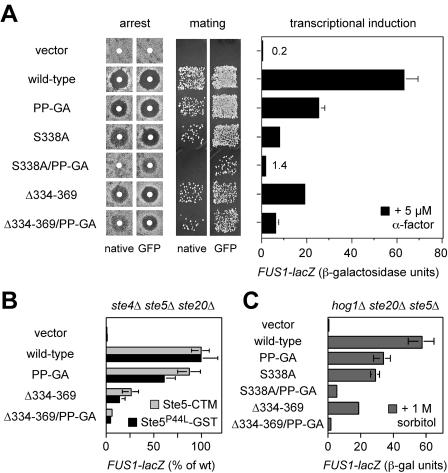FIG. 2.
Phenotypic consequences of point mutations (PP-GA) in the Bem1-binding site. In all panels, the vector is pRS316, and native STE20 and GFP-STE20 plasmids are as described in Table 2. (A) Mating pathway phenotypes of strains with the Ste20 PP-GA mutation, alone and in combination with mutations in the CRIB domain. Arrest (left) and mating (center) results are shown for both native and GFP-fused versions of each Ste20 mutant. Induction of the transcriptional reporter FUS1-lacZ by α-factor (5 μM; 2 h) is shown for the GFP fusions (right) as means ± standard deviations (n = 4). All assays used strain PPY913. (B) The effect of the PP-GA mutation on mating pathway signaling is independent of pheromone and Gβγ. Ste20-dependent signaling was activated in the absence of pheromone or Gβ (Ste4) by galactose-induced synthesis of Ste5-CTM (pH-GS5-CTM) or Ste5P44L-GST (pH-SL2); the host strain, PPY866 (ste4Δ ste5Δ ste20Δ), also harbored the indicated GFP-STE20 constructs. After a 3-h galactose treatment, FUS1-lacZ induction was measured (mean ± standard deviation; n = 9). To facilitate comparison between the two Ste5 reagents, results were expressed relative to those for wild-type (wt) Ste20, which yielded 134 (Ste5-CTM) and 88.3 (Ste5P44L-GST) mean raw units. (C) Hyperosmotic cross talk signaling shows that the effect of the PP-GA mutation is also independent of Ste5. Strain PPY1691 (hog1Δ ste20Δ ste5Δ) harboring the indicated GFP-STE20 constructs was treated with 1 M sorbitol for 3 h, after which FUS1-lacZ induction was measured (mean ± standard deviation; n = 3). Mean expression in cells not induced with sorbitol was <1 U (data not shown). Similar results were observed for hog1Δ ste20Δ and hog1Δ ste4Δ ste5Δ ste20Δ strains (data not shown).

